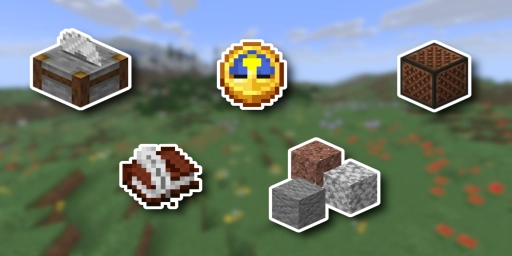Over more than 15 years, Minecraft has amassed a wealth of features, some of which inevitably slip from memory. Not every item or block can be equally useful, but many fun and often extremely practical aspects of the game have faded into the background over time. So we’ve put together a list that shines a light on exactly those things! You might find a few of these items and mechanics worth weaving into your world or your gameplay. We think they’re well worth a look and shouldn’t be forgotten.
Minecraft Stonecutter: Save resources when crafting

If you overlook the Stonecutter, you’re literally missing out on hundreds of resources in some cases. With it, you no longer need to remember stairs, slabs and wall recipes—just pop in a suitable stone-type block and you’re set. You can convert pretty much anything it supports: from full blocks to polished slabs or to walls and back again. That saves a huge amount of effort and, above all, resources.
You can use the Stonecutter for practically any harder block in the stone family: including mud bricks, copper, sandstone and prismarine. Important: the Stonecutter gives a one-to-one yield on slabs and stairs, whereas the crafting table often “eats” material. If you build a lot with these blocks, use the Stonecutter instead of the crafting table.
Minecraft Granite, Diorite and Andesite: Effective building with polished variants

The three stone variants granite, diorite and andesite have been in the game since 2014, but they’re often underestimated and end up in chests rather than builds. Diorite in particular gets ignored because of its busy pattern. Yet all three polish beautifully and combine well with other blocks—the polished variants look cleaner and more modern.
Tips:
- Combine polished diorite with quartz or white terracotta for bright, clean designs.
- Granite pairs nicely with bricks and copper for warm, rustic builds.
- Andesite harmonises with stone bricks and deepslate for industrial looks.
- Use the Stonecutter to switch quickly between slabs, stairs and walls.
Minecraft Concrete: Hardening Concrete Powder properly

Many players don’t realise concrete exists in Minecraft—or avoid it because it’s resource-intensive. For eight Concrete Powder, you’ll need a dye of your choice plus 4x sand and 4x gravel. You then need to harden the powder in water to get solid concrete.
Why it’s worth the effort: concrete offers bold, uniform colours and a very clean texture—perfect for modern builds, pixel art or accents.
Pro tips:
- Set up a water stream: place Concrete Powder into flowing water so it hardens instantly and is faster to break.
- Use a Haste beacon and an Efficiency pickaxe to farm large quantities more quickly.
- While there are no slabs or stairs made of concrete, you can create fantastic colour combos with coloured wool, stained glass or terracotta.
Minecraft leather armour dyeing: Endless colours and powder snow protection

Many players quickly switch to iron, diamond or netherite—but leather armour has unique advantages. You can dye it freely to create a completely individual look. In Java, you dye in the crafting table; in Bedrock, use a cauldron. You can combine multiple dyes, giving you virtually unlimited shades.
A genuine gameplay advantage: leather boots let you walk on powder snow—in mountain biomes that can be a lifesaver. For explorers and builders, a dyed leather set also makes a stylish roleplay element.
Minecraft clock: Telling the time underground

The clock is a relic from the early days, but still useful—especially underground, when you can’t see the surface. It tells you whether it’s day or night, helping you avoid nasty surprises from mobs when you resurface.
Handy: place the clock in an item frame—it keeps working there and becomes a decorative wall clock. You can occasionally find clocks in ruined portals or shipwrecks.
Minecraft Note Blocks: Music, instruments and Redstone tips

Note Blocks are among the most creative blocks in the game. They can be tuned across just over two octaves (25 pitches), letting you compose your own melodies. The instrument depends on the block underneath—e.g., harp/piano, cow bell or bit (chiptune). There are more than 15 instruments in total.
Tips for better tracks:
- Tune by right-clicking, trigger notes with Redstone (e.g., use repeaters for timing).
- Use different instruments by changing the block underneath (wood, ore blocks, sand, etc.).
- You’ll find plenty of examples on YouTube of full songs recreated in Minecraft—perfect for learning.
Minecraft Book and Quill: In‑game notebook for projects

With a Book and Quill, you can capture your project plans right in the game—no more scraps of paper. Ideal for to‑do lists, build plans or coordinates. You can craft one on day one if you have sugar cane (paper), leather, a feather and an ink sac.
Important:
- Click “Done” after new notes so you can continue editing the book later.
- Only when you “Sign” the book does it become a Written Book, which can no longer be changed—perfect for archived plans or server lore.
Conclusion: Make smart use of underrated Minecraft items and features
Minecraft’s richness of features sometimes means some items and blocks get overlooked. Take a little time to explore these forgotten and underrated elements—you never know what might prove useful later or spark creativity. Rent one of our Minecraft servers and discover some of these aspects of the game for yourself. Perhaps you’ve also got things that hardly anyone uses but that you value and enjoy using.
More interesting articles
Minecraft Peaceful Mode: Tips, limits and hidden challenges
Minecraft: 10 hidden features you should know
Minecraft villager trading: The best trades for emeralds, enchantments and armour




